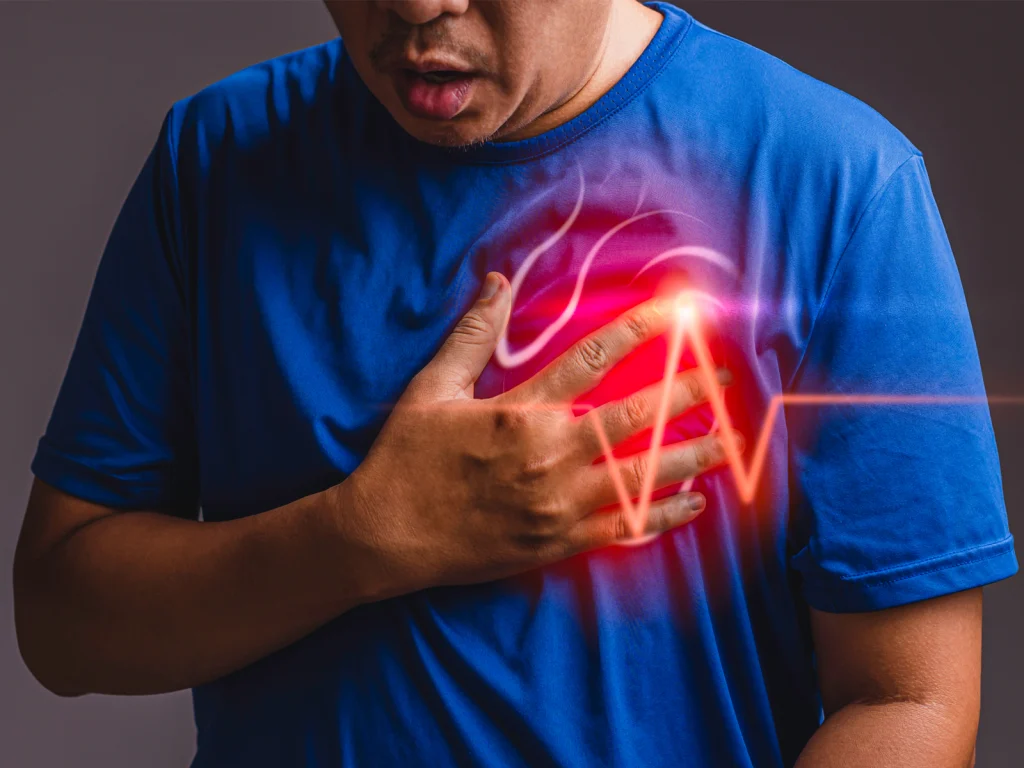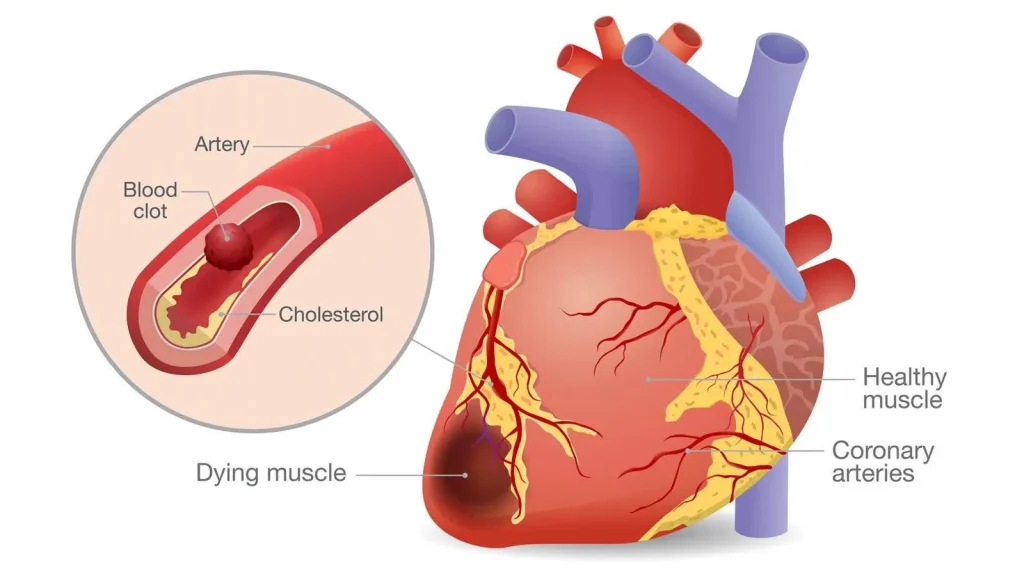Heart disease is one of the main causes of death globally, and distinguishing between angina and a heart attack is crucial for effective treatment and prevention. According to the World Health Organization (WHO), cardiovascular diseases (CVDs) are the number one cause of death globally, taking an estimated 17.9 million lives each year. Both conditions are heart-related and might present with identical symptoms, but identifying them early can save lives. This blog will look at the early symptoms, causes, differences, preventative techniques, and answers to frequent questions regarding angina and heart attacks.

What is Angina?
Angina is a form of chest pain or discomfort caused by a lack of oxygen-rich blood reaching the heart muscles. It is not a sickness, but rather a sign of an underlying cardiac condition, particularly coronary artery disease (CAD). Angina is frequently caused by exertion, stress, or other conditions that raise the heart’s need for oxygen.
What is a Heart Attack?
A heart attack, also known as a myocardial infarction (MI), occurs when blood supply to a portion of the heart is interrupted for a prolonged period of time, causing damage or death to the heart muscle. This a blockage is frequently caused by a blood clot in a restricted or blocked coronary artery. A heart attack is a medical emergency that must be treated immediately to avoid serious cardiac damage.
Early Symptoms of Angina and Heart Attack
Angina Symtoms
- Chest Pain or Discomfort: A sensation of pressure, tightness, or heaviness in the chest is the most typical sign of angina.
- Pain Radiation: The neck, jaw, back, stomach, shoulders, and arms—particularly the left arm—may all experience discomfort.
- Shortness of Breath: Breathing problems can arise, especially when exercising or under stress.
- Nausea and Fatigue: During an angina attack, some people may experience nausea, feeling dizzy, or exhaustion.
- Relieved by Rest or Medication: Usually, rest or the use of drugs like nitroglycerin will relieve angina symptoms.
Heart Attack Symptoms
- Severe Chest Pain or Pressure: During a heart attack, patients frequently experience severe, crushing chest pain that may come and go or stay more than a few minutes.
- Pain Moving to Other Regions: Heart attack pain might spread to the left arm, neck, jaw, back, and stomach, just like angina does.
- Shortness of Breath: Chest discomfort may be associated with tightening or difficulty breathing.
- Sweating and Headaches: Severe sweating, lightheadedness, or dizziness may indicate a heart attack.
- Vomiting and Nausea: Women are particularly at risk for experiencing nausea, vomiting, or indigestion.
- Feeling of Imminent Doom: A lot of people express feeling apprehensive or as though something is terribly wrong.

Differences Between Angina and Heart Attack
While both conditions share some similar symptoms, there are key differences to help distinguish between the two:
Duration and Severity
Heart attack pain is often more severe and prolonged, lasting more than 15 minutes, although angina discomfort typically lasts a few minutes and goes away with rest.
Cause
A heart attack happens when a blockage stops blood from getting to the heart muscle, whereas angina happens when the heart’s oxygen demand exceeds than the available blood supply, frequently as a result of limited arteries.
Pain Relief
Angina symptoms often resolve with rest or medicine such as nitroglycerin, however heart attack symptoms remain and need immediate medical attention.
Damage
Angina does not result in lasting heart damage, whereas a heart attack causes the loss of heart muscle tissue and some time death.
Causes of Angina and Heart Attack
Causes of Angina
- Atherosclerosis: The development of fatty deposits (plaque) in the coronary arteries, which reduces blood flow.
- Coronary Spasm: A temporary narrowing of the coronary arteries produced by spasms, which are commonly caused by smoking, stress, or drug usage.
- Increased Heart Demand: Physical effort, emotional stress, or heavy meals all enhance the heart’s oxygen demand.
Causes of Heart Attack
- Atherosclerosis and Plaque Rupture: When a plaque ruptures in a coronary artery, it generates a clot, which prevents blood flow to the heart muscle.
- Coronary Artery Spasm: A spasm in the coronary artery can cause it to narrow or shut, resulting in a heart attack.
- Blood Clots: When blood clots develop in the arterial walls due to damage, this can cause a full blockage, leading to a heart attack.

Prevention of Angina and Heart Attack
While it is not always possible to prevent heart problems, there are certain changes in lifestyle that may significantly decrease the risk:
- Healthy Diet: A well-balanced diet rich in fruits and vegetables, whole grains, lean meats, and healthy fats will help improve heart health.
- Regular Exercise: Physical activity for at least 30 minutes every day promotes healthy blood circulation and strengthens the heart.
- Quit smoking: Smoking is a significant risk factor for heart disease. By quitting smoking can help you have better heart health overall.
- Manage Stress: Chronic stress can lead to heart disease. Relaxation practices such as yoga and meditation can assist in alleviating stress.
- Control Blood Pressure and Cholesterol: Keeping blood pressure and cholesterol levels within normal limits reduces the risk of heart disease.
- Avoid Excessive Alcohol: Moderate alcohol use can help avoid high blood pressure and other heart-related issues.
For Your Information
- Do you know what CT angiography is? A complete guidance for the patients Click here and learn some interesting facts about that.
Conclusion
Recognizing the earliest symptoms of angina and heart attack is critical for timely diagnosis and treatment. Angina is a warning sign of upcoming heart issues, but a heart attack is a medical emergency requiring immediate attention. Individuals who understand the major distinctions, causes, and preventative techniques can take proactive efforts to protect their heart health.
FAQs
1. How can I tell if I am having a heart attack or angina?
Angina pain typically goes away with rest, while heart attack pain is more severe and persistent, lasting longer than 15 minutes.
2. Can angina lead to a heart attack?
Yes, angina indicates an underlying heart condition and increases the risk of a heart attack, particularly if left untreated.
3. Are heart attack symptoms different for women?
Yes, women may experience less typical symptoms, such as nausea, vomiting, shortness of breath, and extreme fatigue, rather than the classic chest pain.
4. What should I do if I think I’m having a heart attack?
Call emergency services immediately. Do not wait for symptoms to subside. Early intervention can save your life.
5. How can I reduce the risk of angina and heart attacks?
Adopting a healthy lifestyle that includes a balanced diet, regular exercise, and managing risk factors like blood pressure, cholesterol, and stress can reduce the risk.